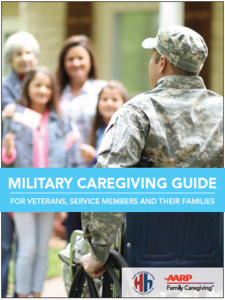
Ron Mori
I am very fortunate to be surrounded by dedicated individuals and teams working on all things related to aging and caregiving at AARP. One area very close to my heart is caregiving. AARP is striving to make it easier for older people to live independently and remain in their homes and communities where they prefer to be, surrounded by family and friends.
By providing planning resources and additional forms of support to family caregivers, AARP hopes to create a country where people can continue to live in their homes and communities for as long as they choose.

New guides like the one picured are available from AARP now.
To help achieve this, AARP is supporting the millions of family caregivers who provide unpaid care to their loved ones with resources and tools. AARP also continues advocating for and providing better quality, affordable and accessible services to help older people live independently and the family caregivers who help them.
Who Is a Caregiver?
A “family caregiver” is defined as an adult age 18 or older who is providing unpaid short-term or long-term care to a parent, spouse, friend or other adult loved one who needs help with everyday activities and personal tasks such as transportation, managing finances, scheduling appointments, shopping, bathing, dressing, preparing meals, wound care and/or medication management.
Family and friends are the backbone of America’s care system, providing the bulk of care for older people in the U.S. as they strive to live independently. If you are not currently a family caregiver, at some point in your life you either will be a caregiver or need a caregiver.
Family caregiving is harder and more complicated than ever as families have increasing demands on their time. Many family caregivers don’t think of themselves as caregivers — they see themselves as sons, daughters, spouses and friends just doing what families do for each other.
Today, family caregivers are asked to carry out health care tasks that would make a first-year nursing student tremble (like wound care, tube feedings) without adequate training.
The job of caregiving that family members do for free can be harder than a job in the paid workforce. Workplace policies that support employee caregivers can also benefit companies by enhancing productivity and enabling workers to keep up with their duties. Almost 3 out of 4 workers age 40 and older say that allowing work flexibility for caregiving would help improve work/life balance.
Emotional and Financial Impact of Caregiving
Family caregivers are at risk of emotional, health and financial problems:
- 38 percent of family caregivers report high emotional stress from the demands of caregiving.
- Nearly half (46 percent) of higher-hour (21 or more hours per week) caregivers report high levels of emotional stress.
- More than half (55 percent) of family caregivers report being overwhelmed by the amount of care their family member needs.
- Nearly 4 in 10 (38 percent) of family caregivers report a moderate (20 percent) to high degree (18 percent) of financial strain as a result of providing care.
- It has been estimated that U.S. businesses lose more than $25 billion annually in lost productivity due to absenteeism among full-time working caregivers. The estimate grows to above $28 billion when part-time working caregivers are included.
- Caregiving can be an all-consuming experience that leaves the caregiver exhausted and lonely. But it can also be an enormously meaningful accomplishment.
AARP Resources
AARP has tools, information and support available for family caregivers. The AARP Caregiving Resource Center (www.aarp.org/caregiving) provides an easy way to join an online community of other family caregivers, learn about local services, get helpful information and connect with others who understand caregiving challenges.
Our newest guide is our Military Caregiving Guide for Veterans, Service Members and Their Families. This 44-page guide, developed in collaboration with the Elizabeth Dole Foundation, addresses the unique issues faced by the 5.5 military caregivers in the U.S. and provides information and resources, glossary of terms, and checklists to help them find and organize more support.
You can download the Military Caregiving Guide at AARP.org.
Ron Mori is a member of the Washington, D.C., JACL chapter and manager of community, states and national affairs — multicultural leadership for AARP.



